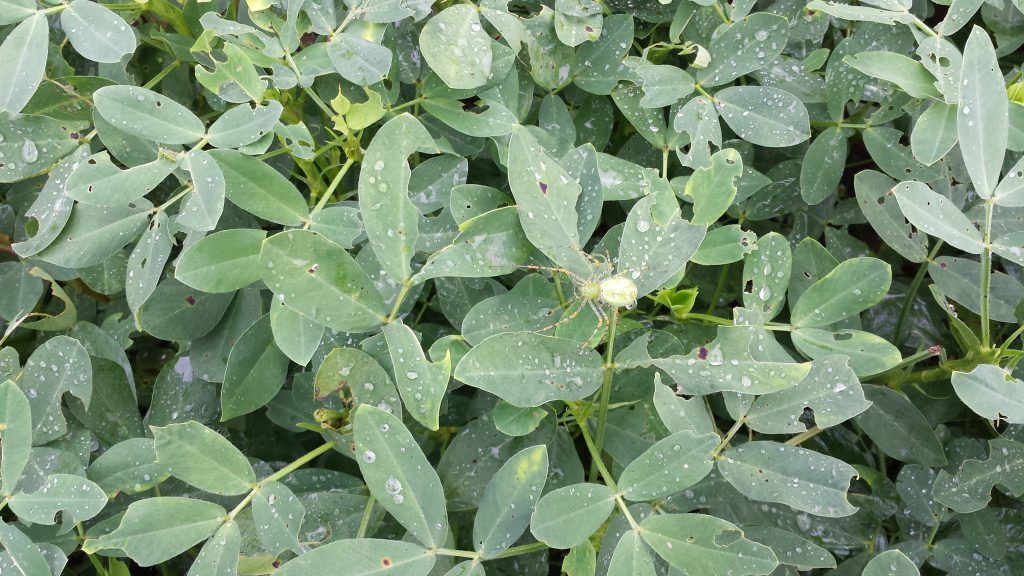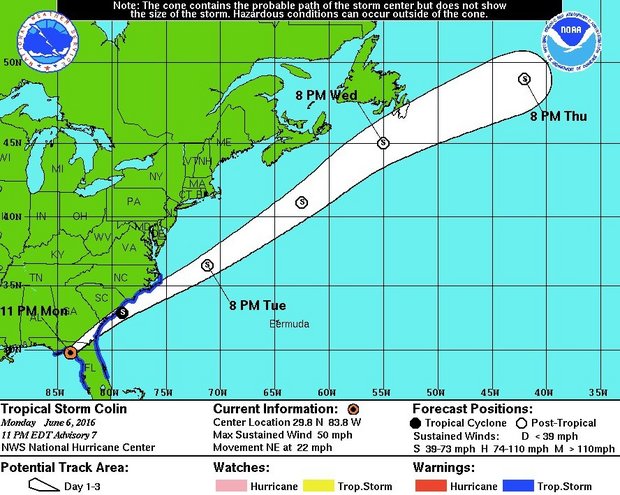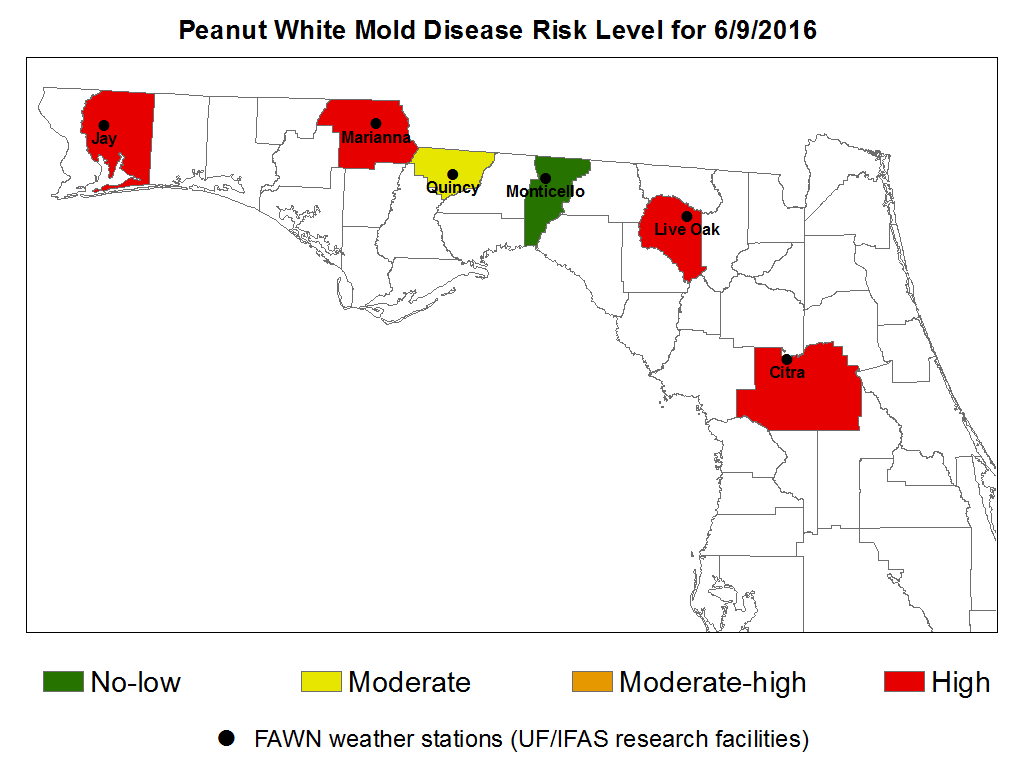
Peanuts with water droplets on leaves after a rainfall event providing free moisture for infection by diseases.
Nicholas Dufault and Rebecca Barocco, UF-IFAS Dept. of Plant Pathology
Back in 2013, the Suwannee Valley as well as other parts of the southeastern U.S. were hit with 10 to 25 inches of rainfall in the month of June, which was partly related to Tropical Storm Andrea. Now that Tropical Storm Colin (Fig. 1) has passed leaving rainfall amounts up to 10 inches in its wake, we are well on our way to another wet June here in Florida. So, what does all the moisture mean for our peanut growers? It means that the environment has become more conducive for disease, but more specifically, that:
- Moisture, especially excess rainfall, creates an environment optimal for fungal pathogens (e.g. early and late leaf spot, rust and white mold) to grow, infect, and spread.
- Too much water can stress peanut plants, and this stress can make the plant more susceptible to infections.
- One of the big things a system like Colin does is spread fungal spores over short and long distances very effectively. Rain splash as well as wind-blown rainfall are efficient means for local dispersal of fungal spores in a field, but these factors are also critical to the release of spores into the atmosphere for long distance movement to fields miles away.
- Too much rain creates problems for growers by limiting access to fields for fungicide sprays and other management practices needed for healthy peanuts.
 |
| Fig. 1. The path of tropical storm Colin on June 6, 2016 from the National Oceanic Atmospheric Administration (http://www.nhc.noaa.gov/). |
So, what can one do about the headaches excess rainfall causes? There is no simple answer to this question, but the first thing would be to assess your risk for disease. Peanut-Rx is a powerful tool for preseason risk assessment and can tell you a lot about how your variety, planting date, and other cultural practices affect disease development. Understanding your risk is an important step to deciding how to respond to environmental events like tropical storm Colin. Peanut-Rx is available at the University of Georgia extension website: 2016 PEANUT Rx or as an app on android and apple mobile devices.
Now that I know something about my preseason risk, how does environment/weather change this risk value? This is also a complicated answer that will depend a lot on the grower’s specific situation. For example, if you have high risk peanuts that are 45 to 50 days old and they have not been treated with a fungicide then the risk for disease would be higher, especially if the pathogen is present. Currently, observations of peanut leaf spots and rust diseases in Florida is low. This means that now would be a good time for a protectant fungicide spray with chlorothalonil (e.g. BravoWS®). However, since it is possible infections have increased since tropical storm Colin, adding a penetrant product like Alto®, Priaxor® and/or tebuconazole (e.g. Tebuzol®) to the spray would be beneficial, especially in high risk fields. There are many other products available for foliar disease control, and the important thing to keep in mind when mixing is to use 2 separate classes of fungicides based on their FRAC numbers.
Another factor to consider when selecting products would be the risk for soilborne diseases (Fig. 2). Some products to consider for both foliar and soilborne disease control would be Provost® and Fontelis®. Each situation will be different, but for high risk fields when environments become favorable it is good to consider using multiple fungicide chemistries and think about switching to a shorter spray interval during that period.
What if the field has a low risk for disease? The environment right now is highly conducive for disease, and it is likely that many foliar pathogens were spread across the region through Tropical Storm Colin. This means that the risk probably increased in low risk fields, but it will be important to pay attention to the variety’s susceptibility to various diseases as you consider adjusting your management program. This does not mean you will have to spray 2 or 3 more times this year, but it is always important to pay attention to how weather impacts our diseases. In this case, the first step would be scouting your fields for the presence of disease and talking with extension personnel and consultants about what diseases are present in the region. In the absence of the pathogen, a protective chlorothalonil spray may be all that is needed in a low risk field. However, if the pathogen is present and you have a susceptible host planted, it would be a good time to mix 2 chemistries as described above and continue scouting to see if the pathogen spreads.
Ultimately, each situation will be unique and nothing makes up for experience when dealing with diseases. The Disease Issue of the Southeastern Peanut Farmer provides some good information on how to handle many diseases and what to consider when selecting fungicide products. If after assessing your risk you have more questions than answers related to your spray decision, it is time to seek advice from extension specialists. It is likely, with the way our season is shaping up, that we will see problems from leaf spots, rust, white mold and Rhizoctonia limb rot this year. The important thing will be to stay ahead of these diseases and adjust your program accordingly to the disease and environment present.
Note: Reference to products in this publication is not intended to be an endorsement to the exclusion of others that may be similar. Products listed are not meant to be a complete list of products.
- 2025 End-of-Season Florida Peanut Disease Notes - October 24, 2025
- Southern Rust Confirmed in the Florida Panhandle – June 2025 - June 6, 2025
- Stay Ahead of Disease with the Spore Report: A New Tool to Assist with Potato and Watermelon Management - April 11, 2025


